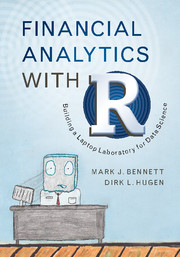Book contents
- Frontmatter
- Dedication
- Contents
- Preface
- Acknowledgments
- 1 Analytical Thinking
- 2 The R Language for Statistical Computing
- 3 Financial Statistics
- 4 Financial Securities
- 5 Dataset Analytics and Risk Measurement
- 6 Time Series Analysis
- 7 The Sharpe Ratio
- 8 Markowitz Mean-Variance Optimization
- 9 Cluster Analysis
- 10 Gauging the Market Sentiment
- 11 Simulating Trading Strategies
- 12 Data Exploration Using Fundamentals
- 13 Prediction Using Fundamentals
- 14 Binomial Model for Options
- 15 Black–Scholes Model and Option-Implied Volatility
- Appendix Probability Distributions and Statistical Analysis
- References
- Index
6 - Time Series Analysis
Published online by Cambridge University Press: 20 October 2016
- Frontmatter
- Dedication
- Contents
- Preface
- Acknowledgments
- 1 Analytical Thinking
- 2 The R Language for Statistical Computing
- 3 Financial Statistics
- 4 Financial Securities
- 5 Dataset Analytics and Risk Measurement
- 6 Time Series Analysis
- 7 The Sharpe Ratio
- 8 Markowitz Mean-Variance Optimization
- 9 Cluster Analysis
- 10 Gauging the Market Sentiment
- 11 Simulating Trading Strategies
- 12 Data Exploration Using Fundamentals
- 13 Prediction Using Fundamentals
- 14 Binomial Model for Options
- 15 Black–Scholes Model and Option-Implied Volatility
- Appendix Probability Distributions and Statistical Analysis
- References
- Index
Summary
You work for an airline in the operations department. They ask you to reach into the historical company and industry datasets and figure out the expected loading for every flight in their book for this coming year. This ties directly into projected revenue. In the back of your mind, you know that expenses for the company need to be offset by revenue. It doesn't help to be overly optimistic because the risk of not meeting the projections carries with it the risk of future disappointment.
What should you do? Passenger boardings are cyclical. There are risks of a downturn. But a downturn could impact profitability of the entire company. The price of oil and jet fuel is important. Mergers happen every year which change the competitive landscape and make some routes more efficient.
Time series analysis can certainly help. Just like confidence intervals in statistics (please see also the Appendix), there is a band of uncertainty around any of the projections. The expected airline passenger loadings is a random variable. Passenger boarding is one of several arenas we will explore with the help of tools in R.
Examining Time Series
We begin with a quick survey of the types of times series we will model. We can use the quantmod and PerformanceAnalytics packages, firstly. We will define the vector of symbols to be downloaded. The symbols GSPC, VIX, TNX, refer to the S&P 500 index, the CME volatility index, and the ten-year treasury yield, respectively. Use the getSymbols() function to download the time series for the symbols in sym.vec between the dates of January 3, 2003 and September 10, 2015. If the quantmod and PerformanceAnalytics packages are not yet installed, they can be installed with the commands install.packages(“quantmod”, dependencies=TRUE) and install.packages(“PerformanceAnalytics”, dependencies=TRUE).
> library(quantmod)
> library(PerformanceAnalytics)
> sym.vec <-c(“∧GSPC”,“∧VIX”)
> getSymbols(sym.vec, from = “2005-01-03”, to = “2015-09-16”)
[1] “GSPC” “VIX”
The first plot is of the S&P 500, shown in Figure 6.1.We see the peak of the market in early 2007 and then the steep decline as the housing crisis hit.We see the market bottom out in mid 2009 and begin a large rally that lasts through mid 2015. We see minor corrections in 2011 and 2012 due to uncertainty surrounding the government debt in the Euro zone, and a significant sell-off in mid 2015 due to uncertainty surrounding China's economy.
- Type
- Chapter
- Information
- Financial Analytics with RBuilding a Laptop Laboratory for Data Science, pp. 92 - 129Publisher: Cambridge University PressPrint publication year: 2016



